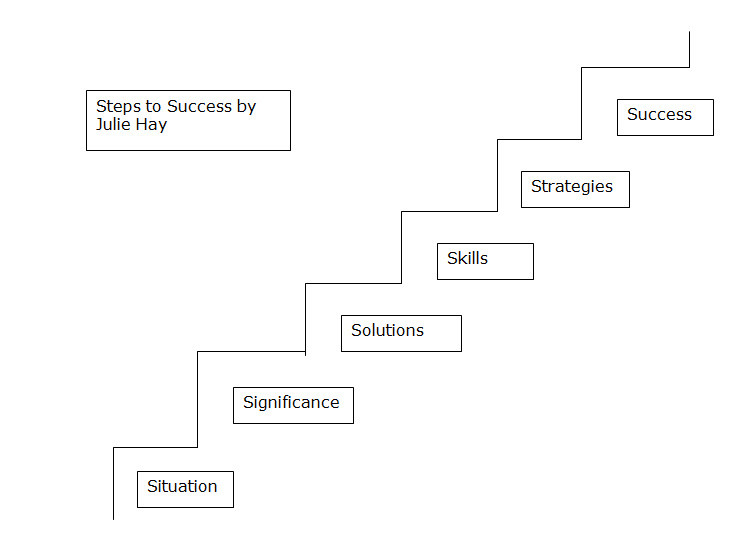Steps to Success: A strategy for coaches and coach supervisors
It becomes obvious why all coaches need supervision if we focus on a process from Transactional Analysis called Discounting. The easiest way to think about this is to see the word discount as a verb. i.e. to discount. So rather like being in a shop where they take something off the price (and discount it), the discounting in coaching terms is when we unwittingly omit something. This shows itself when people minimise or ignore things about themselves, others or a situation.
Why do we discount i.e. omit certain information?
We discount because we are human and we are trying to maintain our sanity. We are being bombarded every waking second with information that we cannot possibly attend to so we “filter” it out – often unconsciously. Therefore we may be working in a room and not notice the buzz of the air-conditioning or the hum of traffic outside. Our attention may only be drawn to it when something out of the ordinary happens e.g. a car horn sounds. So essentially, this is a healthy process we engage in but it can also be our undoing too.
When we discount information, we are maintaining the map of the world we have set up. We will then filter any other stimulus coming in from the outside world through our current map of the world. If it doesn’t fit then we may reject it even if it’s wrong. E.g. if we believe someone is careless we will look for evidence to keep supporting this “story” or vice versa.
Another interesting point with discounting is that we see it more often when others are doing it rather than ourselves: it’s often blindingly obvious when others do it! This can create problems in coaching if, as coaches, we see something that a client is discounting. If we rush to point this out we may get a baffled response or blank looks.
So we need to find a way of “being where the client is” first of all - coming down to their level and then slowly helping them to raise awareness alongside them.
A strategy for coaches and coach supervisors
Julie Hay in her book “Reflective Practise and Supervision for Coaches” (2007) highlights a Steps to Success strategy for coaches to help clients with.

This is also a helpful process in supervision too whether it’s a one to one session between a supervisor and a supervisee or amongst a reflective group. Therefore we can substitute “supervisee” for all references to clients below.
Level 1 Situation.
At this level, the client may not even be aware of something in the situation that they need to pay attention to i.e. the classic case of “they don’t know what they don’t know”. Therefore this is the most serious level of discounting.
E.g. not noticing when someone has become upset in an interaction.
If challenged on this by the coach the client may be genuinely puzzled.
In a supervision scenario this might be the supervisee not noticing a client smiling or fiddling with their watch at a significant point. However unless the coaching session is recorded or the supervisor is guessing/being very intuitive then this may not even come into awareness for either of them. Continual discounting like this means no change can happen until the supervisee can bring the situational factors into their awareness.
Level 2 Significance
At this level the client/supervisee notices what is happening in the situation but discounts its significance.
i.e. the client has spotted the upset colleagues but rationalises it in another way; or the supervisee spots the smiling but does not see the disconnect with the type of content at the moment of the smile.
As coaches and supervisors we can often detect these discounts easily and be tempted to point them out and provide solutions; which we know doesn’t work! The person on the receiving end looks blank or irritated. Therefore as John Whitmore put it “I am able to control only that which I am aware of. That which I am unaware of controls me. Awareness empowers me”.
What to do:
As you are at this level and your client is not, you have to step down one of the levels back to “situation”. Asking questions to elicit that what they see is the same as you, and then you can draw out what the significance of these observations is before moving onto the next level Solutions.
Level 3 Solutions
Ok, so now your client is aware of the problem and this maybe enough for some people to plan some strategies for action. However you can get some who will discount all the possible solutions to this problem e. g. “clients often smile inappropriately don’t they and it doesn’t mean anything?” Again, it can be difficult not to offer solutions.
Remember that discounting is an attempt by the person to maintain their frame of reference or map of the world, so they will defend this by believing there are no options to solve the problem. This might be from shame or embarrassment that they could have done something about this earlier.
What to do:
In NLP terms we could help by providing some “towards” motivations (carrots) or “away from” motivation (sticks) depending on the client’s preference. E.g. encourage clients on how much better things would be if we found a way to change or how much worse things could be.
Level 4 Skills
By this stage it’s easier for us to counter the discounting as they are moving up the steps, although sometimes you can get stuck at this stage too.
This time they may want to continue with their frame of reference by discounting that they even have skills to do this (or even that others don’t have the requisite skills. e.g. “Other coaches are better at picking up on these smiles than me, I will never be good at that” or “My staff won’t know how to do that”)
What to do:
Encourage deeper consideration of skills as possibilities of how they could be acquired. Don’t join in with their frame of reference as it will reinforce the idea of not being able to learn or change. Getting them to look at the consequences of their beliefs on not being able to up-skill may be the insight they need.
Levels 5 Strategies
If by this stage the client still wants to maintain the status quo then you will see this in the stalling of any strategies to solve this problem. E.g. “I’m too busy/there’s no budget for this”
What to do:
Detailed questioning is needed to challenge the assumptions behind these “reasons”.
Level 6 Success
At this level everything seems to be sorted but there is still something causing inaction. E.g. they may seem motivated but fail to commit to a timescale.
What to do:
A challenge at this level maybe about their beliefs on success and failure. Ask them:
- What are the hidden benefits of taking no action?
- What are the hidden disadvantages to changing?
So next time you are stuck and your client is too, think about what might they be discounting? What might you as a coach be discounting? And get on the same step together.
For more details on how to overcome problems associated with discounting or how to build the Steps to Success, please do get in touch julia@sparkcoachingandtraining.co.uk

